Primary Health Care Nursing Report: Murray Clinic Analysis
VerifiedAdded on 2020/03/04
|7
|2306
|93
Report
AI Summary
This report provides an overview of primary health care nursing, focusing on the healthcare services offered at the Murray Clinic. It details the different types of healthcare services, including primary, secondary, and tertiary care, and their respective functions. The report further analyzes the socio-demographic characteristics of patients, such as age, gender, education, labor market status, and occupation, and how these factors influence health outcomes. It highlights specific patient groups, including those with functional dyspepsia, cancer patients, and individuals with sickle cell disease, examining their unique needs and characteristics. The report also discusses the potential influence of socio-demographic factors on nursing practice within the clinic, emphasizing the importance of tailored care and the role of nurses in addressing patient needs and promoting health. The report references several studies and provides a comprehensive understanding of primary health care nursing in this setting.
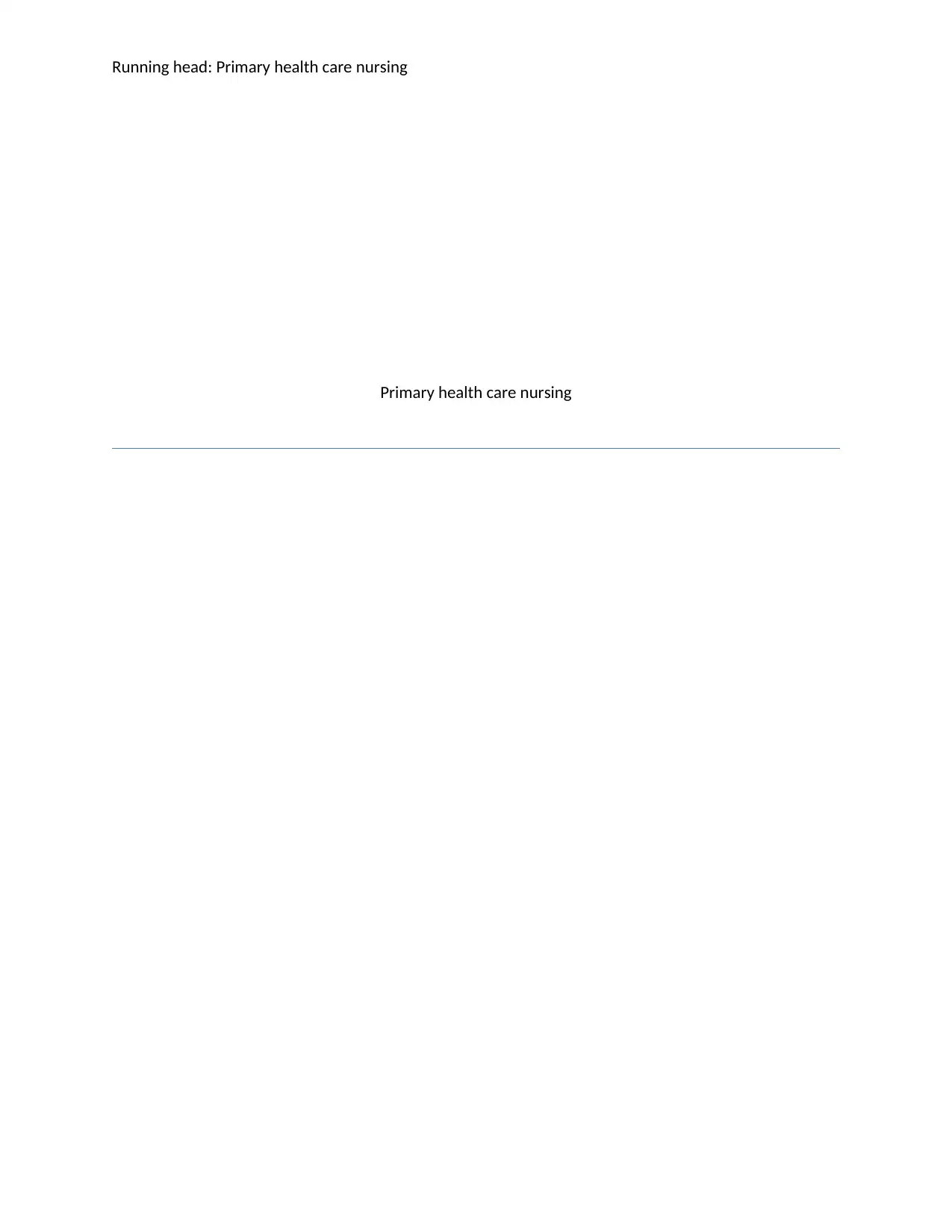
Running head: Primary health care nursing
Primary health care nursing
Primary health care nursing
Paraphrase This Document
Need a fresh take? Get an instant paraphrase of this document with our AI Paraphraser
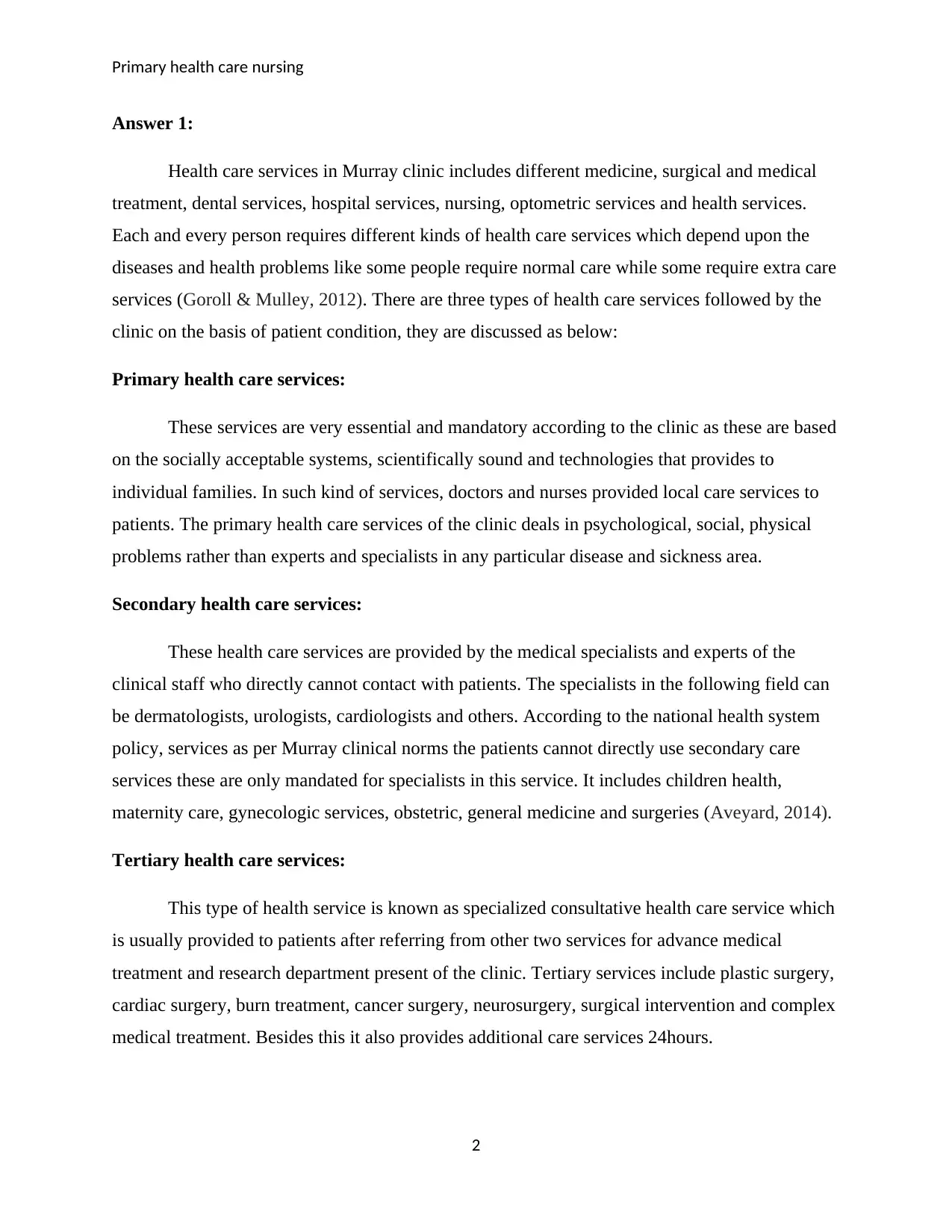
Primary health care nursing
Answer 1:
Health care services in Murray clinic includes different medicine, surgical and medical
treatment, dental services, hospital services, nursing, optometric services and health services.
Each and every person requires different kinds of health care services which depend upon the
diseases and health problems like some people require normal care while some require extra care
services (Goroll & Mulley, 2012). There are three types of health care services followed by the
clinic on the basis of patient condition, they are discussed as below:
Primary health care services:
These services are very essential and mandatory according to the clinic as these are based
on the socially acceptable systems, scientifically sound and technologies that provides to
individual families. In such kind of services, doctors and nurses provided local care services to
patients. The primary health care services of the clinic deals in psychological, social, physical
problems rather than experts and specialists in any particular disease and sickness area.
Secondary health care services:
These health care services are provided by the medical specialists and experts of the
clinical staff who directly cannot contact with patients. The specialists in the following field can
be dermatologists, urologists, cardiologists and others. According to the national health system
policy, services as per Murray clinical norms the patients cannot directly use secondary care
services these are only mandated for specialists in this service. It includes children health,
maternity care, gynecologic services, obstetric, general medicine and surgeries (Aveyard, 2014).
Tertiary health care services:
This type of health service is known as specialized consultative health care service which
is usually provided to patients after referring from other two services for advance medical
treatment and research department present of the clinic. Tertiary services include plastic surgery,
cardiac surgery, burn treatment, cancer surgery, neurosurgery, surgical intervention and complex
medical treatment. Besides this it also provides additional care services 24hours.
2
Answer 1:
Health care services in Murray clinic includes different medicine, surgical and medical
treatment, dental services, hospital services, nursing, optometric services and health services.
Each and every person requires different kinds of health care services which depend upon the
diseases and health problems like some people require normal care while some require extra care
services (Goroll & Mulley, 2012). There are three types of health care services followed by the
clinic on the basis of patient condition, they are discussed as below:
Primary health care services:
These services are very essential and mandatory according to the clinic as these are based
on the socially acceptable systems, scientifically sound and technologies that provides to
individual families. In such kind of services, doctors and nurses provided local care services to
patients. The primary health care services of the clinic deals in psychological, social, physical
problems rather than experts and specialists in any particular disease and sickness area.
Secondary health care services:
These health care services are provided by the medical specialists and experts of the
clinical staff who directly cannot contact with patients. The specialists in the following field can
be dermatologists, urologists, cardiologists and others. According to the national health system
policy, services as per Murray clinical norms the patients cannot directly use secondary care
services these are only mandated for specialists in this service. It includes children health,
maternity care, gynecologic services, obstetric, general medicine and surgeries (Aveyard, 2014).
Tertiary health care services:
This type of health service is known as specialized consultative health care service which
is usually provided to patients after referring from other two services for advance medical
treatment and research department present of the clinic. Tertiary services include plastic surgery,
cardiac surgery, burn treatment, cancer surgery, neurosurgery, surgical intervention and complex
medical treatment. Besides this it also provides additional care services 24hours.
2
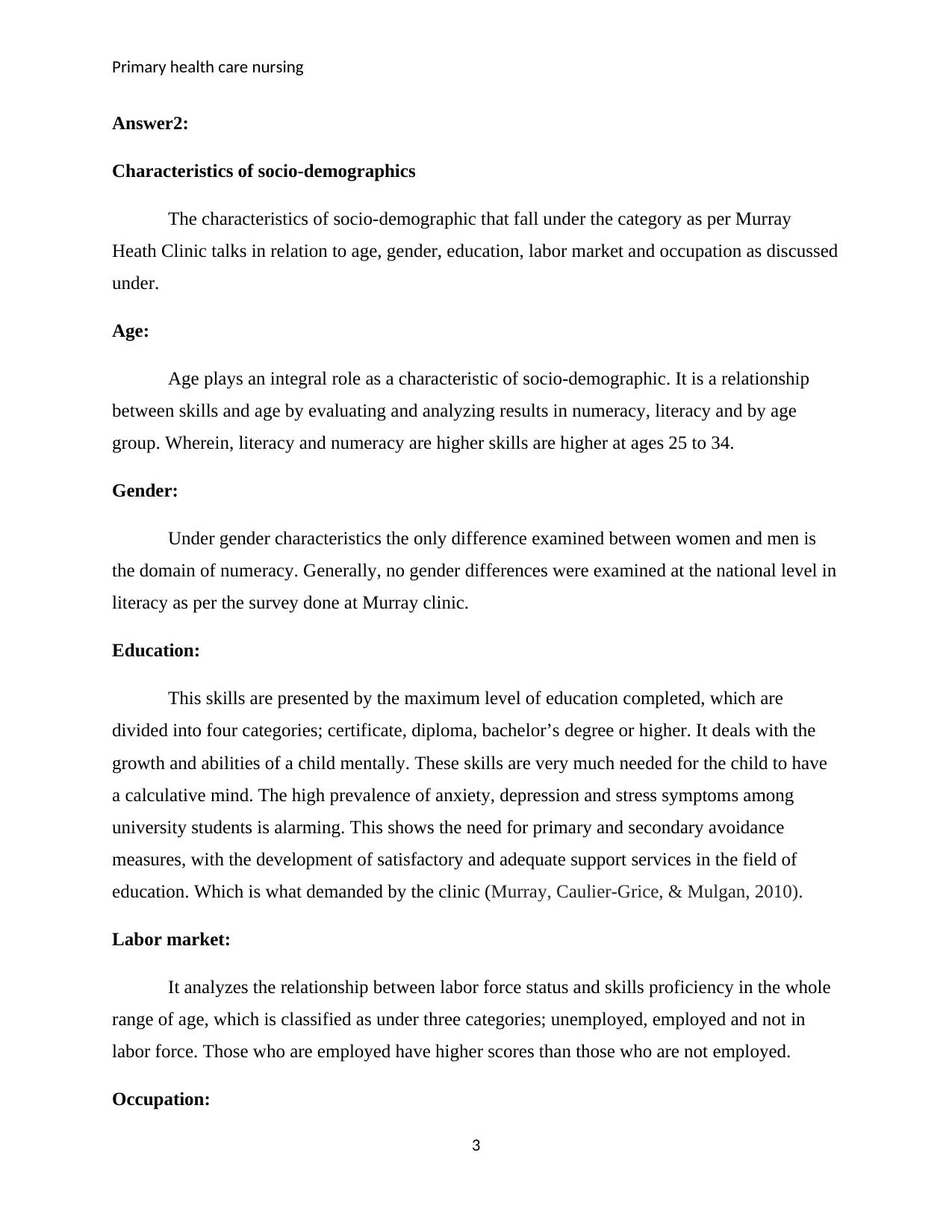
Primary health care nursing
Answer2:
Characteristics of socio-demographics
The characteristics of socio-demographic that fall under the category as per Murray
Heath Clinic talks in relation to age, gender, education, labor market and occupation as discussed
under.
Age:
Age plays an integral role as a characteristic of socio-demographic. It is a relationship
between skills and age by evaluating and analyzing results in numeracy, literacy and by age
group. Wherein, literacy and numeracy are higher skills are higher at ages 25 to 34.
Gender:
Under gender characteristics the only difference examined between women and men is
the domain of numeracy. Generally, no gender differences were examined at the national level in
literacy as per the survey done at Murray clinic.
Education:
This skills are presented by the maximum level of education completed, which are
divided into four categories; certificate, diploma, bachelor’s degree or higher. It deals with the
growth and abilities of a child mentally. These skills are very much needed for the child to have
a calculative mind. The high prevalence of anxiety, depression and stress symptoms among
university students is alarming. This shows the need for primary and secondary avoidance
measures, with the development of satisfactory and adequate support services in the field of
education. Which is what demanded by the clinic (Murray, Caulier-Grice, & Mulgan, 2010).
Labor market:
It analyzes the relationship between labor force status and skills proficiency in the whole
range of age, which is classified as under three categories; unemployed, employed and not in
labor force. Those who are employed have higher scores than those who are not employed.
Occupation:
3
Answer2:
Characteristics of socio-demographics
The characteristics of socio-demographic that fall under the category as per Murray
Heath Clinic talks in relation to age, gender, education, labor market and occupation as discussed
under.
Age:
Age plays an integral role as a characteristic of socio-demographic. It is a relationship
between skills and age by evaluating and analyzing results in numeracy, literacy and by age
group. Wherein, literacy and numeracy are higher skills are higher at ages 25 to 34.
Gender:
Under gender characteristics the only difference examined between women and men is
the domain of numeracy. Generally, no gender differences were examined at the national level in
literacy as per the survey done at Murray clinic.
Education:
This skills are presented by the maximum level of education completed, which are
divided into four categories; certificate, diploma, bachelor’s degree or higher. It deals with the
growth and abilities of a child mentally. These skills are very much needed for the child to have
a calculative mind. The high prevalence of anxiety, depression and stress symptoms among
university students is alarming. This shows the need for primary and secondary avoidance
measures, with the development of satisfactory and adequate support services in the field of
education. Which is what demanded by the clinic (Murray, Caulier-Grice, & Mulgan, 2010).
Labor market:
It analyzes the relationship between labor force status and skills proficiency in the whole
range of age, which is classified as under three categories; unemployed, employed and not in
labor force. Those who are employed have higher scores than those who are not employed.
Occupation:
3
⊘ This is a preview!⊘
Do you want full access?
Subscribe today to unlock all pages.

Trusted by 1+ million students worldwide
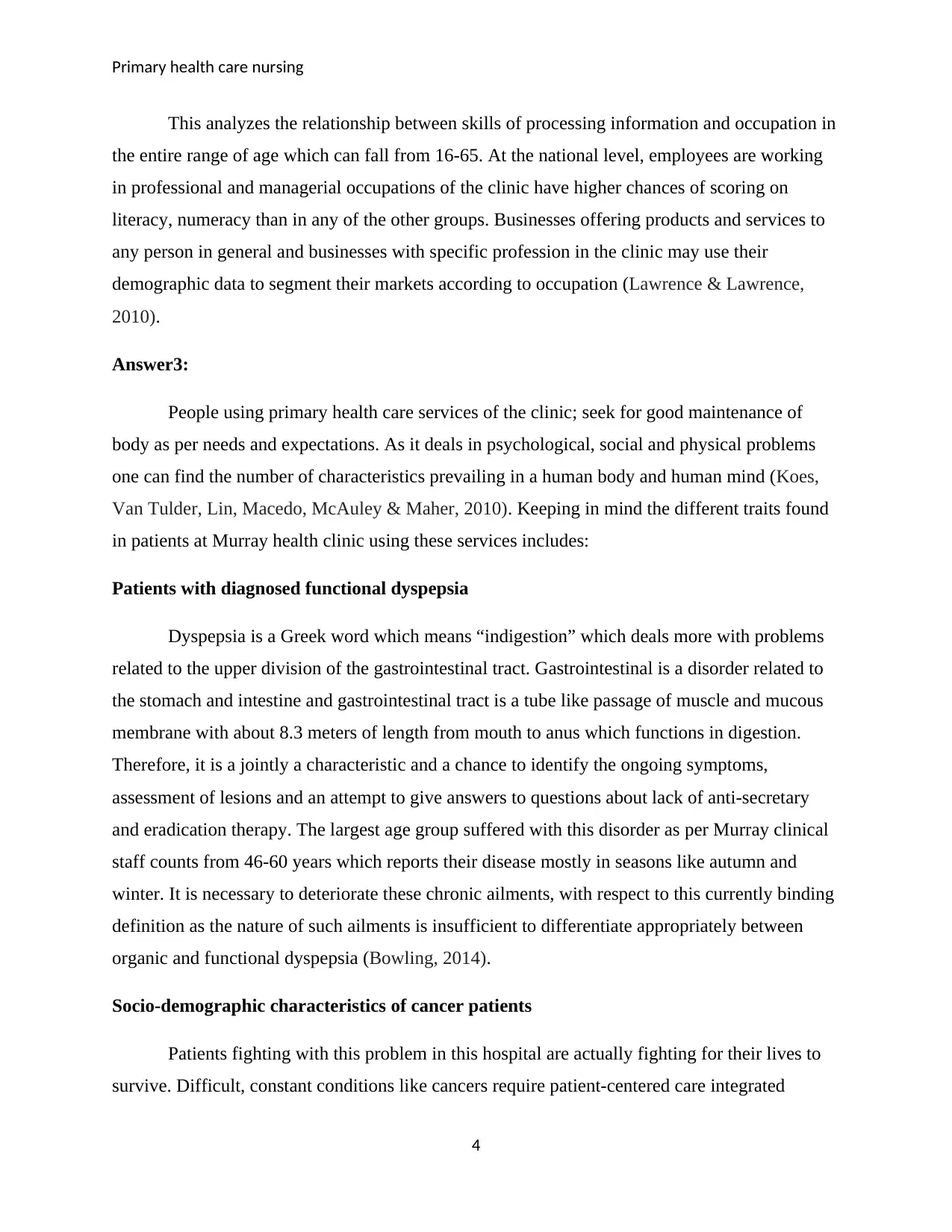
Primary health care nursing
This analyzes the relationship between skills of processing information and occupation in
the entire range of age which can fall from 16-65. At the national level, employees are working
in professional and managerial occupations of the clinic have higher chances of scoring on
literacy, numeracy than in any of the other groups. Businesses offering products and services to
any person in general and businesses with specific profession in the clinic may use their
demographic data to segment their markets according to occupation (Lawrence & Lawrence,
2010).
Answer3:
People using primary health care services of the clinic; seek for good maintenance of
body as per needs and expectations. As it deals in psychological, social and physical problems
one can find the number of characteristics prevailing in a human body and human mind (Koes,
Van Tulder, Lin, Macedo, McAuley & Maher, 2010). Keeping in mind the different traits found
in patients at Murray health clinic using these services includes:
Patients with diagnosed functional dyspepsia
Dyspepsia is a Greek word which means “indigestion” which deals more with problems
related to the upper division of the gastrointestinal tract. Gastrointestinal is a disorder related to
the stomach and intestine and gastrointestinal tract is a tube like passage of muscle and mucous
membrane with about 8.3 meters of length from mouth to anus which functions in digestion.
Therefore, it is a jointly a characteristic and a chance to identify the ongoing symptoms,
assessment of lesions and an attempt to give answers to questions about lack of anti-secretary
and eradication therapy. The largest age group suffered with this disorder as per Murray clinical
staff counts from 46-60 years which reports their disease mostly in seasons like autumn and
winter. It is necessary to deteriorate these chronic ailments, with respect to this currently binding
definition as the nature of such ailments is insufficient to differentiate appropriately between
organic and functional dyspepsia (Bowling, 2014).
Socio-demographic characteristics of cancer patients
Patients fighting with this problem in this hospital are actually fighting for their lives to
survive. Difficult, constant conditions like cancers require patient-centered care integrated
4
This analyzes the relationship between skills of processing information and occupation in
the entire range of age which can fall from 16-65. At the national level, employees are working
in professional and managerial occupations of the clinic have higher chances of scoring on
literacy, numeracy than in any of the other groups. Businesses offering products and services to
any person in general and businesses with specific profession in the clinic may use their
demographic data to segment their markets according to occupation (Lawrence & Lawrence,
2010).
Answer3:
People using primary health care services of the clinic; seek for good maintenance of
body as per needs and expectations. As it deals in psychological, social and physical problems
one can find the number of characteristics prevailing in a human body and human mind (Koes,
Van Tulder, Lin, Macedo, McAuley & Maher, 2010). Keeping in mind the different traits found
in patients at Murray health clinic using these services includes:
Patients with diagnosed functional dyspepsia
Dyspepsia is a Greek word which means “indigestion” which deals more with problems
related to the upper division of the gastrointestinal tract. Gastrointestinal is a disorder related to
the stomach and intestine and gastrointestinal tract is a tube like passage of muscle and mucous
membrane with about 8.3 meters of length from mouth to anus which functions in digestion.
Therefore, it is a jointly a characteristic and a chance to identify the ongoing symptoms,
assessment of lesions and an attempt to give answers to questions about lack of anti-secretary
and eradication therapy. The largest age group suffered with this disorder as per Murray clinical
staff counts from 46-60 years which reports their disease mostly in seasons like autumn and
winter. It is necessary to deteriorate these chronic ailments, with respect to this currently binding
definition as the nature of such ailments is insufficient to differentiate appropriately between
organic and functional dyspepsia (Bowling, 2014).
Socio-demographic characteristics of cancer patients
Patients fighting with this problem in this hospital are actually fighting for their lives to
survive. Difficult, constant conditions like cancers require patient-centered care integrated
4
Paraphrase This Document
Need a fresh take? Get an instant paraphrase of this document with our AI Paraphraser
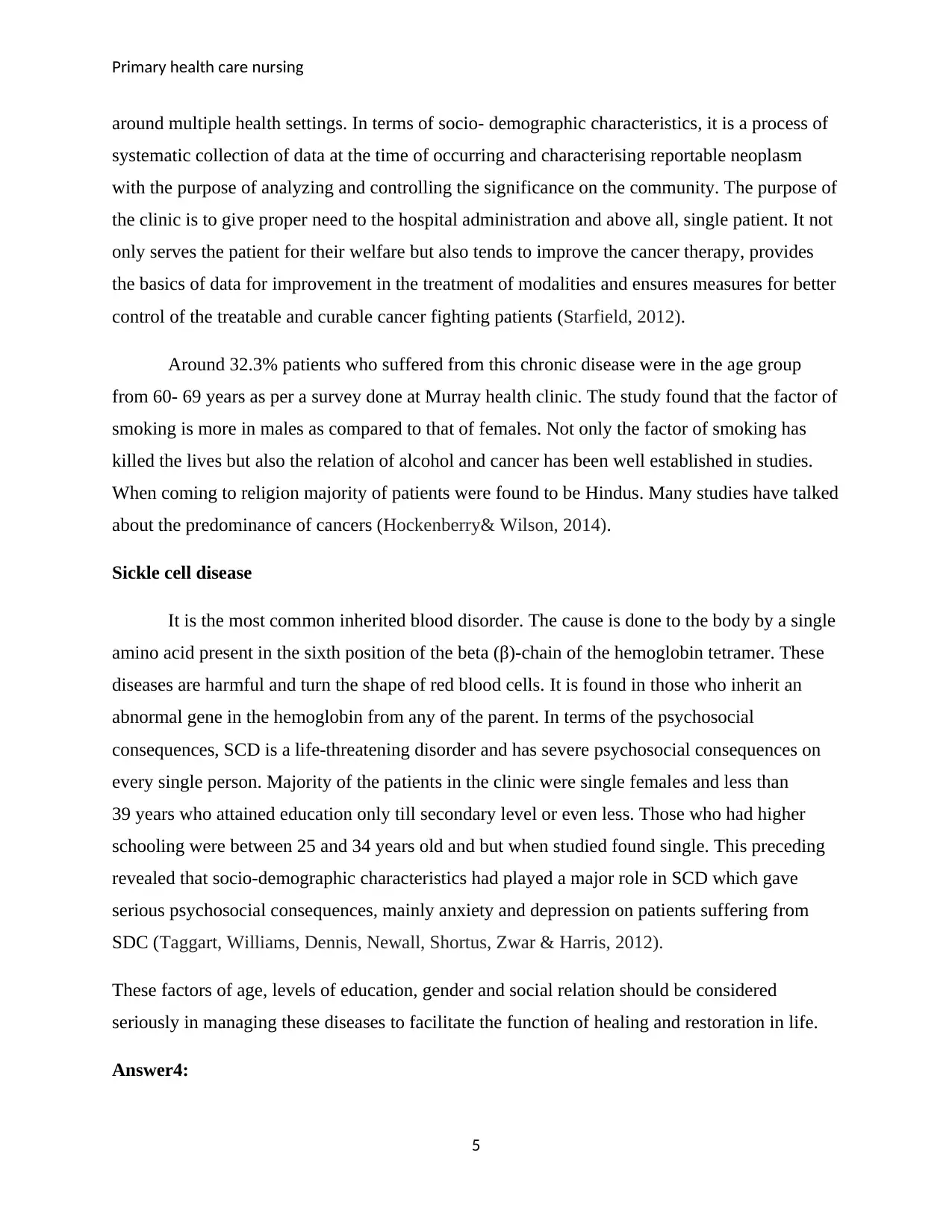
Primary health care nursing
around multiple health settings. In terms of socio- demographic characteristics, it is a process of
systematic collection of data at the time of occurring and characterising reportable neoplasm
with the purpose of analyzing and controlling the significance on the community. The purpose of
the clinic is to give proper need to the hospital administration and above all, single patient. It not
only serves the patient for their welfare but also tends to improve the cancer therapy, provides
the basics of data for improvement in the treatment of modalities and ensures measures for better
control of the treatable and curable cancer fighting patients (Starfield, 2012).
Around 32.3% patients who suffered from this chronic disease were in the age group
from 60- 69 years as per a survey done at Murray health clinic. The study found that the factor of
smoking is more in males as compared to that of females. Not only the factor of smoking has
killed the lives but also the relation of alcohol and cancer has been well established in studies.
When coming to religion majority of patients were found to be Hindus. Many studies have talked
about the predominance of cancers (Hockenberry& Wilson, 2014).
Sickle cell disease
It is the most common inherited blood disorder. The cause is done to the body by a single
amino acid present in the sixth position of the beta (β)-chain of the hemoglobin tetramer. These
diseases are harmful and turn the shape of red blood cells. It is found in those who inherit an
abnormal gene in the hemoglobin from any of the parent. In terms of the psychosocial
consequences, SCD is a life-threatening disorder and has severe psychosocial consequences on
every single person. Majority of the patients in the clinic were single females and less than
39 years who attained education only till secondary level or even less. Those who had higher
schooling were between 25 and 34 years old and but when studied found single. This preceding
revealed that socio-demographic characteristics had played a major role in SCD which gave
serious psychosocial consequences, mainly anxiety and depression on patients suffering from
SDC (Taggart, Williams, Dennis, Newall, Shortus, Zwar & Harris, 2012).
These factors of age, levels of education, gender and social relation should be considered
seriously in managing these diseases to facilitate the function of healing and restoration in life.
Answer4:
5
around multiple health settings. In terms of socio- demographic characteristics, it is a process of
systematic collection of data at the time of occurring and characterising reportable neoplasm
with the purpose of analyzing and controlling the significance on the community. The purpose of
the clinic is to give proper need to the hospital administration and above all, single patient. It not
only serves the patient for their welfare but also tends to improve the cancer therapy, provides
the basics of data for improvement in the treatment of modalities and ensures measures for better
control of the treatable and curable cancer fighting patients (Starfield, 2012).
Around 32.3% patients who suffered from this chronic disease were in the age group
from 60- 69 years as per a survey done at Murray health clinic. The study found that the factor of
smoking is more in males as compared to that of females. Not only the factor of smoking has
killed the lives but also the relation of alcohol and cancer has been well established in studies.
When coming to religion majority of patients were found to be Hindus. Many studies have talked
about the predominance of cancers (Hockenberry& Wilson, 2014).
Sickle cell disease
It is the most common inherited blood disorder. The cause is done to the body by a single
amino acid present in the sixth position of the beta (β)-chain of the hemoglobin tetramer. These
diseases are harmful and turn the shape of red blood cells. It is found in those who inherit an
abnormal gene in the hemoglobin from any of the parent. In terms of the psychosocial
consequences, SCD is a life-threatening disorder and has severe psychosocial consequences on
every single person. Majority of the patients in the clinic were single females and less than
39 years who attained education only till secondary level or even less. Those who had higher
schooling were between 25 and 34 years old and but when studied found single. This preceding
revealed that socio-demographic characteristics had played a major role in SCD which gave
serious psychosocial consequences, mainly anxiety and depression on patients suffering from
SDC (Taggart, Williams, Dennis, Newall, Shortus, Zwar & Harris, 2012).
These factors of age, levels of education, gender and social relation should be considered
seriously in managing these diseases to facilitate the function of healing and restoration in life.
Answer4:
5
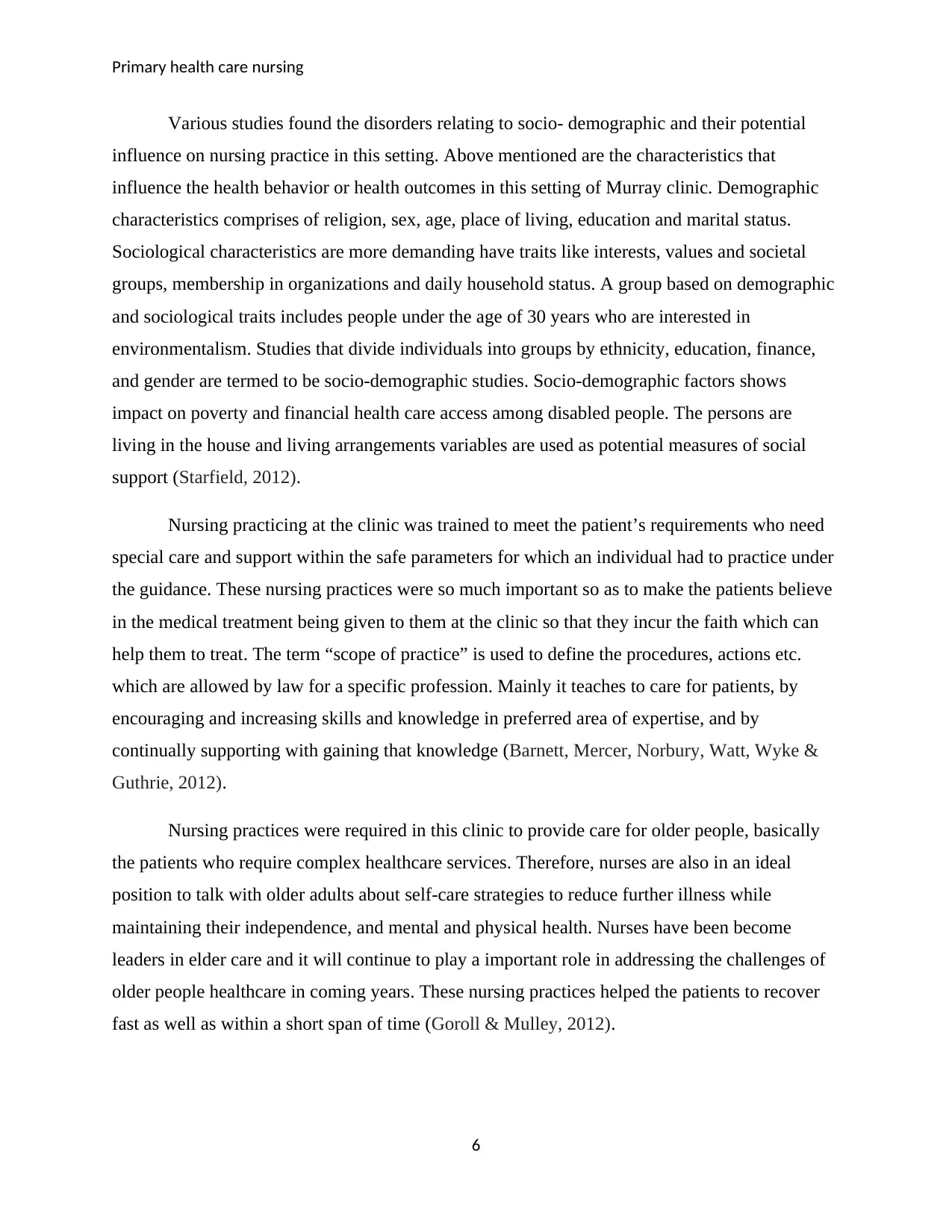
Primary health care nursing
Various studies found the disorders relating to socio- demographic and their potential
influence on nursing practice in this setting. Above mentioned are the characteristics that
influence the health behavior or health outcomes in this setting of Murray clinic. Demographic
characteristics comprises of religion, sex, age, place of living, education and marital status.
Sociological characteristics are more demanding have traits like interests, values and societal
groups, membership in organizations and daily household status. A group based on demographic
and sociological traits includes people under the age of 30 years who are interested in
environmentalism. Studies that divide individuals into groups by ethnicity, education, finance,
and gender are termed to be socio-demographic studies. Socio-demographic factors shows
impact on poverty and financial health care access among disabled people. The persons are
living in the house and living arrangements variables are used as potential measures of social
support (Starfield, 2012).
Nursing practicing at the clinic was trained to meet the patient’s requirements who need
special care and support within the safe parameters for which an individual had to practice under
the guidance. These nursing practices were so much important so as to make the patients believe
in the medical treatment being given to them at the clinic so that they incur the faith which can
help them to treat. The term “scope of practice” is used to define the procedures, actions etc.
which are allowed by law for a specific profession. Mainly it teaches to care for patients, by
encouraging and increasing skills and knowledge in preferred area of expertise, and by
continually supporting with gaining that knowledge (Barnett, Mercer, Norbury, Watt, Wyke &
Guthrie, 2012).
Nursing practices were required in this clinic to provide care for older people, basically
the patients who require complex healthcare services. Therefore, nurses are also in an ideal
position to talk with older adults about self-care strategies to reduce further illness while
maintaining their independence, and mental and physical health. Nurses have been become
leaders in elder care and it will continue to play a important role in addressing the challenges of
older people healthcare in coming years. These nursing practices helped the patients to recover
fast as well as within a short span of time (Goroll & Mulley, 2012).
6
Various studies found the disorders relating to socio- demographic and their potential
influence on nursing practice in this setting. Above mentioned are the characteristics that
influence the health behavior or health outcomes in this setting of Murray clinic. Demographic
characteristics comprises of religion, sex, age, place of living, education and marital status.
Sociological characteristics are more demanding have traits like interests, values and societal
groups, membership in organizations and daily household status. A group based on demographic
and sociological traits includes people under the age of 30 years who are interested in
environmentalism. Studies that divide individuals into groups by ethnicity, education, finance,
and gender are termed to be socio-demographic studies. Socio-demographic factors shows
impact on poverty and financial health care access among disabled people. The persons are
living in the house and living arrangements variables are used as potential measures of social
support (Starfield, 2012).
Nursing practicing at the clinic was trained to meet the patient’s requirements who need
special care and support within the safe parameters for which an individual had to practice under
the guidance. These nursing practices were so much important so as to make the patients believe
in the medical treatment being given to them at the clinic so that they incur the faith which can
help them to treat. The term “scope of practice” is used to define the procedures, actions etc.
which are allowed by law for a specific profession. Mainly it teaches to care for patients, by
encouraging and increasing skills and knowledge in preferred area of expertise, and by
continually supporting with gaining that knowledge (Barnett, Mercer, Norbury, Watt, Wyke &
Guthrie, 2012).
Nursing practices were required in this clinic to provide care for older people, basically
the patients who require complex healthcare services. Therefore, nurses are also in an ideal
position to talk with older adults about self-care strategies to reduce further illness while
maintaining their independence, and mental and physical health. Nurses have been become
leaders in elder care and it will continue to play a important role in addressing the challenges of
older people healthcare in coming years. These nursing practices helped the patients to recover
fast as well as within a short span of time (Goroll & Mulley, 2012).
6
⊘ This is a preview!⊘
Do you want full access?
Subscribe today to unlock all pages.

Trusted by 1+ million students worldwide
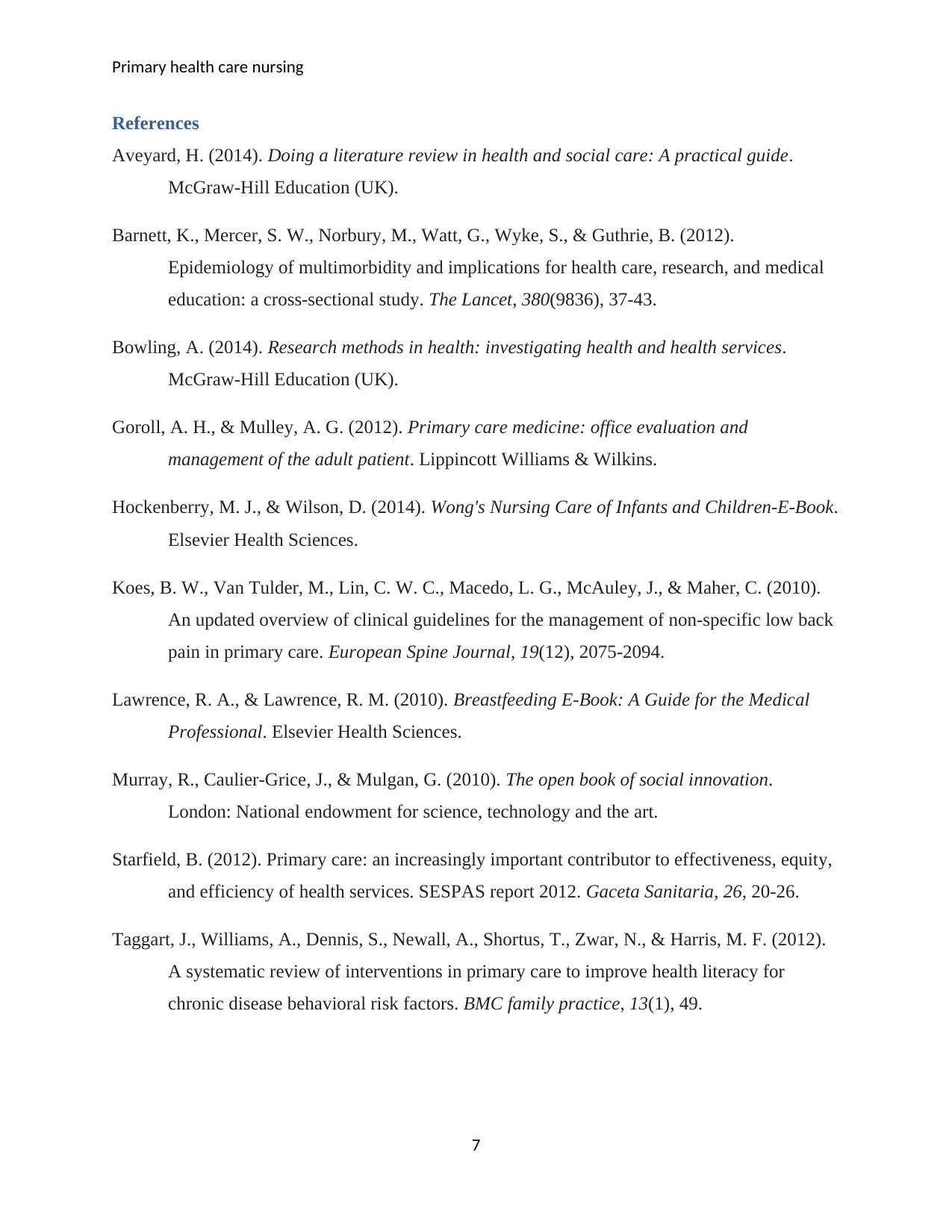
Primary health care nursing
References
Aveyard, H. (2014). Doing a literature review in health and social care: A practical guide.
McGraw-Hill Education (UK).
Barnett, K., Mercer, S. W., Norbury, M., Watt, G., Wyke, S., & Guthrie, B. (2012).
Epidemiology of multimorbidity and implications for health care, research, and medical
education: a cross-sectional study. The Lancet, 380(9836), 37-43.
Bowling, A. (2014). Research methods in health: investigating health and health services.
McGraw-Hill Education (UK).
Goroll, A. H., & Mulley, A. G. (2012). Primary care medicine: office evaluation and
management of the adult patient. Lippincott Williams & Wilkins.
Hockenberry, M. J., & Wilson, D. (2014). Wong's Nursing Care of Infants and Children-E-Book.
Elsevier Health Sciences.
Koes, B. W., Van Tulder, M., Lin, C. W. C., Macedo, L. G., McAuley, J., & Maher, C. (2010).
An updated overview of clinical guidelines for the management of non-specific low back
pain in primary care. European Spine Journal, 19(12), 2075-2094.
Lawrence, R. A., & Lawrence, R. M. (2010). Breastfeeding E-Book: A Guide for the Medical
Professional. Elsevier Health Sciences.
Murray, R., Caulier-Grice, J., & Mulgan, G. (2010). The open book of social innovation.
London: National endowment for science, technology and the art.
Starfield, B. (2012). Primary care: an increasingly important contributor to effectiveness, equity,
and efficiency of health services. SESPAS report 2012. Gaceta Sanitaria, 26, 20-26.
Taggart, J., Williams, A., Dennis, S., Newall, A., Shortus, T., Zwar, N., & Harris, M. F. (2012).
A systematic review of interventions in primary care to improve health literacy for
chronic disease behavioral risk factors. BMC family practice, 13(1), 49.
7
References
Aveyard, H. (2014). Doing a literature review in health and social care: A practical guide.
McGraw-Hill Education (UK).
Barnett, K., Mercer, S. W., Norbury, M., Watt, G., Wyke, S., & Guthrie, B. (2012).
Epidemiology of multimorbidity and implications for health care, research, and medical
education: a cross-sectional study. The Lancet, 380(9836), 37-43.
Bowling, A. (2014). Research methods in health: investigating health and health services.
McGraw-Hill Education (UK).
Goroll, A. H., & Mulley, A. G. (2012). Primary care medicine: office evaluation and
management of the adult patient. Lippincott Williams & Wilkins.
Hockenberry, M. J., & Wilson, D. (2014). Wong's Nursing Care of Infants and Children-E-Book.
Elsevier Health Sciences.
Koes, B. W., Van Tulder, M., Lin, C. W. C., Macedo, L. G., McAuley, J., & Maher, C. (2010).
An updated overview of clinical guidelines for the management of non-specific low back
pain in primary care. European Spine Journal, 19(12), 2075-2094.
Lawrence, R. A., & Lawrence, R. M. (2010). Breastfeeding E-Book: A Guide for the Medical
Professional. Elsevier Health Sciences.
Murray, R., Caulier-Grice, J., & Mulgan, G. (2010). The open book of social innovation.
London: National endowment for science, technology and the art.
Starfield, B. (2012). Primary care: an increasingly important contributor to effectiveness, equity,
and efficiency of health services. SESPAS report 2012. Gaceta Sanitaria, 26, 20-26.
Taggart, J., Williams, A., Dennis, S., Newall, A., Shortus, T., Zwar, N., & Harris, M. F. (2012).
A systematic review of interventions in primary care to improve health literacy for
chronic disease behavioral risk factors. BMC family practice, 13(1), 49.
7
1 out of 7
Related Documents
Your All-in-One AI-Powered Toolkit for Academic Success.
+13062052269
info@desklib.com
Available 24*7 on WhatsApp / Email
![[object Object]](/_next/static/media/star-bottom.7253800d.svg)
Unlock your academic potential
Copyright © 2020–2025 A2Z Services. All Rights Reserved. Developed and managed by ZUCOL.





